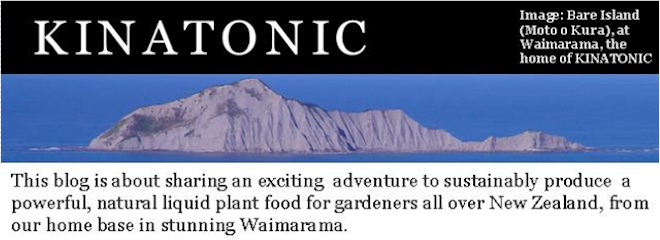INGREDIENTS:

PROCEDURE:

LAYER 1. Fresh Greens (Nitrogen): (above) Mow your lawn (and clip your hedge as a further option) , the pile shown is 6 ‘catchers’ of grass clippings. It is important that the clippings are used on the day of mowing. Fresh is best as lawn clippings rapidly decompose and lose the natural Nitrogen we require as a vital ingredient in our Compost Cake. Spread the clippings out on a tarpolin or other mat. The pile in the picture is about 2 metres long by 1 metre wide by 300mm high. At this point fill your watering can with 1 litre of Kinatonic Black and add 5 litres of water.
Sprinkle about a quarter of the dilute Kinatonic black on the grass clippings. , then add a small handful of garden lime sprinkled over the pile. (as below).

Layer 2: Browns (Carbon): The picture below showns the contents of about 4 x 20 litre containers of dried old leaves we have collected from under our hedges and trees. We did take a little time to extract the enividible larger twigs that come with this exercise , although this is no critical. We have spread the leaves evenly over the grass clippings to form Layer 2. Now add to this another quarter of your watering can of dilute Kinatonic Black , and another small handful of garden lime.

Layer 3. More Carbon: We chose to add some straw as we had some spare to hand. However this is not crucial. Shredded newspaper is all that is needed. We used a 20 litre bucket of straw and about half a 20 litre container of shredded newspaper (about 2 newspapers , ripped up into pieces no larger than a chequebook). If you have no straw , just shred an extra newspaper. Now to this layer add a further quarter of the dilute Kinatonic Black , and a handful of lime. You may also want to use the garden hose to sprinkle and wet the newpaper if windy. Be careful not to overwet though , just enough to stop the paper blowing away. Please note that ‘combined’ Carbon ingredient (Dry Leaves , Paper , Straw) should be about 20% more in volume compared to your Greens (Clipping, Trimmings , Weeds , Kitchen Scraps).

Layer 4. Carbon and Nitrogen: We added (below) some garden weeds as the y were fresh and handy. We also added some seaweed , about 10 dried heads of Ecklonia Radiata we had collected previously. Both these items are optional. Seaweed may be used wet/fresh , but should be chopped into smallish pieces with a machete or similar. At this point your may use the contents of your kitchen scraps bucket also if you chose. Seaweed is a vital ingredient in composting , and should be sort if possible …. Each time you go to the beach collect a rubbish bag full and hang it to dry on your fence or simply leave it in an open container near your compost bin for addition to your regular compost heap or for your next Compost Cake day.

Layer 5. The Icing: A small bucket (10 litres max) of compost from your pile , or a previous cake , or if neither of these are available , use a good black soil from the garden. This is highly important as Kinatonic Black will provide most of the soil microbes that really makes compost rock , but adding your own compost or black soil will aid in the activation process. Now to layer 5 , add the final quarter of the dilute Kinatonic Black and a handful of lime.

Mixing Stage: Now thoroughly mix the ‘cake’ (below). Using a garden fork , start from the inside and work out. The finished article should look something like this. If you feel the ‘cake’ is a tad dry (you want the finished article to be damp , but not wet , bit like the dampness of a wrung out sponge) , then add a sprinkling of water from the hose to get your consistency right. This is highly important as if too wet then the cake will go slimey , if too dry it will not compost properly. Having the newspaper in the mix provides an excellent guide as to the correct moisture content. When we see all the newspaper damp after mixing , we know the moisture content near perfect.

The Cooking Stage: (below) Now either use the tarpolin you mixed your cake on to cover it (as we have) , and secure with rocks , or fork the mix into a 200 litre compost bin or similar. Put your hand into the cake the next day to ensure she’s cookin , careful tho , temperatures may reach up to 70 degrees in the pile , which is important for killing off weed seeds and any plant diseases that are in the mix.

Now then , every 2 weeks (or every week if you want to speed the process) , lift the tarpolin and mix the ingredients again with your garden fork , perhaps adding a sprinkle of water if the pile looks to dry.
Repeat process fortnightly , and after 8 weeks you will have your very own REAL COMOST , which will be suitable (with a light sieving) for potting mix , or general use on your garden!!
Enjoy!!!






















